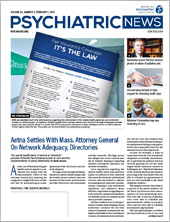The use of quotations in electronic medical records can provide clarity in otherwise complex narratives provided by patients. Direct quotations allow for a snapshot of the interaction between a patient and a provider and can enhance documentation in a way that a summary or commentary on the interaction may not be able to capture. For example, documenting a patient’s concern that the “FBI is monitoring me through the Wi-Fi” helps other health care professionals understand the depth of the patient’s psychotic symptoms and may be more useful than documenting experiences as paranoid delusions.
There is concern, however, that certain patient quotations may introduce bias by implying exaggerated or factitious histories or revealing low socioeconomic status. A study by A.P. Goddu et al. posted January 26, 2018, in the Journal of General Internal Medicine indicated that inclusion of certain patient quotations in the medical record can impact clinical evaluation and judgment. The study utilized a factitious vignette of a patient affected by a sickle cell crisis, and respondents were asked to read documentation that included quotations from the patient describing his pain as “all up in my arms and legs” and “still a 10,” acutely worsening after “wheeling himself all the way over to McDonald’s to hang out with a friend.” The authors hypothesized that quotations such as these had the potential to introduce biases, as they may cast doubt on the patient’s level of pain or imply a lower socioeconomic status. The study found that the quoted patient was subject to more negative attitudes and less aggressive pain management than a patient whose documentation was more objectively summarized.
Although this study indicated how quotations can introduce bias, documentation of patients’ own words can also help health care professionals contextualize the patient interaction. For example, the quotation from the patient above may help other health care professionals understand that the patient is wheelchair dependent and may not have adequate means of transportation not only to meet a friend for lunch, but also to get to appointments for follow-up care. Information regarding structural factors and individual circumstances can arise from patient quotations, offering clues to help better understand the patient in a broader context.
The nuances of language, however, may limit the utility of some patient quotations. In the example above, very little is added to the narrative when the patient’s pain is described as “still a 10.” Using this direct quotation may lead other readers to be suspicious or mistrustful about the patient’s level of pain and does not introduce any opportunities for advocacy or support in the evaluation and treatment plan. When health care professionals feel that a quotation may lend to bias, they can instead summarize the interaction and choose documentation that more objectively describes the situation (“the patient is experiencing 10/10 pain”).
Quotations have also been used for patients who prefer to use a name other than their given name at birth, particularly those who may identify with a gender that is different from their assigned gender. Although efforts to include these preferred names in the medical record should be encouraged, putting the preferred names in quotation marks may lead some readers to view the name in contempt, given that quotations (and how they can be interpreted as “air quotes”) can imply expressions of irony, satire, or sarcasm, according to Martina Lampert in the December 2013 English Today from Cambridge University Press. LGBTQ advocacy groups discourage the use of quotations for preferred name, for example Joseph (preferred name: Emma) has a more affirming and inclusive tone than Joseph (“Emma”).
The language in medical records can influence others in ways that many health care professionals may not be aware of. Quotations can add depth and context to the documentation of a clinical encounter, but they also carry a risk of introducing bias. Psychiatrists and mental health professionals should carefully consider the risks and benefits of using direct patient quotations, particularly when working with a mental health population that is susceptible to stigma and bias. ■
“Do Words Matter? Stigmatizing Language and the Transmission of Bias in the Medical Record” can be accessed
here. “Say, Be Like, Quote (Unquote), and the Air Quotes: Interactive Quotatives and Their Multimodal Implications: The ‘New’ Quotatives Remind Us of the Vocal, Verbal, and Gestural Dimensions of Speech” is available
here.

